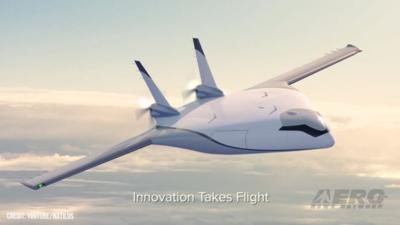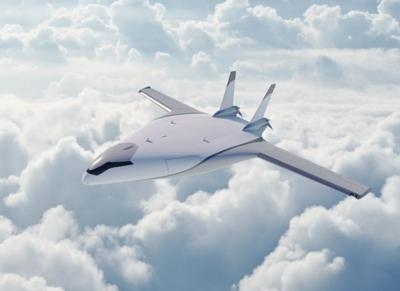Thrust Reversal
Founded in 2016 by former Piper lead aerodynamicist Aleksey Matyushev and aerospace engineer Anatoly Star, San Diego, California-based Natilus is a designer and builder of autonomous cargo aircraft. The company plans to fly a full-scale prototype of its Blended-Wing-Body (BWB) concept—dubbed Kona—in 2024.

Natilus announced a partnership with British/American hydrogen-electric aero-propulsion-system concern ZeroAvia, by which the two companies will jointly develop hydrogen-electric engines for Natilus’s nascent Kona cargo aircraft. According to a statement put forth by the two firms, ZeroAvia’s ZA600, 600-kilowatt hydrogen-electric engine is to be the sole hydrogen-electric propulsion scheme Natilus will make available to buyers of its novel Kona short-haul feeder UAV.
The announcement belies Natilus’s formerly expressed intention to power its Kona aircraft with conventional turboprop engines—an expression substantiated by the company’s 2022 contractual agreement with Pratt & Whitney for acquisition of the engine-maker’s PT6A-67D turboprop engines.
To the subject of alternative powerplants, Natilus co-founder and CEO Aleksey Matyushev stated in April 2023: “Electrification is great, but not at the range and payloads we’re talking about. We don’t want to carry one pound of cargo and all batteries. It just doesn’t make a lot of sense; that technology is still not quite there yet for the routes that our customers are most interested in.”
Comes now May 2023, and Mr. Matyushev, in an apparent reversal of operational ethos, asserted: “Natilus has a long-term commitment to being a responsible steward of our environment, instituting practices that can protect the environment through continual improvements to save fuel and water, reduce waste, air emissions, noise, and material consumption. The Natilus-ZeroAvia partnership goes further, bringing the talents and innovations of the two companies together to deliver much needed innovation in the air cargo delivery industry and multiple solutions for our customers.”
In April 2023, Natilus successfully completed multiple flights of a subscale prototype of its Kona aircraft. The test aircraft took-off from a private runway in Southern California and reached speeds of 61-knots. Stability had been among the key shortcomings of the BWB design; the April test flights, however, demonstrated that Natilus’s BWB aircraft configuration is capable of flying in the absence of complex autopilot systems.
In the heady afterglow of the promising flight-testing campaign, Mr. Matyushev stated: “We are fully focused on completing the full-scale Kona prototype. Our Kona remotely piloted aircraft will be capable of carrying over nine-thousand pounds of freight and will open new markets worldwide. The progress of Natilus developing autonomous cargo aircraft is a game-changer in the logistics industry, providing an efficient and cost-effective solution for shipping goods across oceans.”
ZeroAvia’s propulsion scheme comprises fuel-cells which generate electricity from compressed, liquid hydrogen fuel. The electricity powers electric motors which turn the host aircraft’s propellers, thereby generating thrust.

On 19 January 2023, ZeroAvia successfully flew a 19-seat Dornier 228 testbed aircraft, the left-engine of which had been replaced with a full-size prototype of the company’s hydrogen-electric powertrain. The test aircraft’s right-engine remained the stock 776-shaft-horsepower Honeywell TPE-331 turboprop with which it left Dornier Flugzeugwerke’s assembly facility.
In its testing configuration, ZeroAvia’s hydrogen-electric powertrain comprised two fuel-cell stacks with lithium-ion battery packs providing peak power support during take-off, and adding a measure of redundancy conducive to safe operations. During the test-flight, the powertrain’s hydrogen tanks and fuel-cell power generation systems were housed within the test aircraft’s cabin. To accommodate passengers and cargo, future commercial incarnations of ZeroAvia’s hydrogen-electric powertrain will utilize external hydrogen storage. The extent to which an assortment of external fuel-tanks compromises Natilus’s BWB architecture remains to be seen.
ZeroAvia founder and CEO Val Miftakhov remarked: “Given Natilus’s impressive order book and corresponding technology development, working together on integrating the ZA600 as a line-fit engine for Kona can multiply the emissions and costs benefits that are already interesting cargo operators. We all depend on air cargo operators, and some communities depend on them absolutely, so improving the economics and environmental impacts of these operations while increasing service levels is a massive opportunity.”
Natilus intends to offer three iterations of its autonomous cargo aircraft: the Kona, a short-haul feeder UAV with a 3.8-metric-ton maximum payload; the Alisio, a medium/long-range UAV with a sixty-metric-ton maximum payload; and the Nordes, a long-range cargo UAV with a one-hundred-metric-ton payload.
Natilus posits its aircraft represent a turnkey fix for a $5-trillion global freight industry the company holds to be imperiled.
To date, Natilus has logged north of $6.8-billion in order commitments and 460+ aircraft pre-orders from major airlines and supply-chain integrators the likes of Ameriflight, Volatus Aerospace, Flexport, Astral, Aurora International, and Dymond.
Natilus asserts its carbon fiber, Blended-Wing-Body cargo aircraft—which are designed to be remotely piloted by licensed UAV operators—can be operated at only forty-percent of the cost of comparably-sized conventional cargo aircraft. The efficiency of the company’s BWB platform derives of its twenty-percent drag-reduction over orthodox fixed-wing architectures. The efficiency of Natilus’s one-hundred-percent reduction in onboard pilots is decidedly less quantifiable.
 NTSB Final Report: Cessna 177B
NTSB Final Report: Cessna 177B ANN's Daily Aero-Term (05.08.25): Final Approach Fix
ANN's Daily Aero-Term (05.08.25): Final Approach Fix Aero-News: Quote of the Day (05.08.25)
Aero-News: Quote of the Day (05.08.25) ANN's Daily Aero-Term (05.09.25): Estimated (EST)
ANN's Daily Aero-Term (05.09.25): Estimated (EST) ANN's Daily Aero-Linx (05.09.25)
ANN's Daily Aero-Linx (05.09.25)




